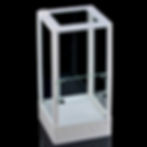We have given the classic natural ant tunnel-digging formicarium a Por Amor Art twist. The formicarium features three entrances on top. Use it as a stand-alone formicarium or an expansion to an already existing setup; it is amusing to see ants dig their own nest while choosing their chambers' quantity, shape, and size.
One of the most common mistakes is moving your colony to a big formicarium too early. Still, it is also hard to make slow, gradual steps as it is hard to find a formicarium design or size that fits the colony's needs precisely; with this formicarium doing so is very easy, remember ants like tight cozy spaces; they get to chose exactly the room they need, slowly expanding as they need.
**The front glass measures 12 x 10 centimetres, and the gap or distance between the glass and rear plastic wall is only 6.4 millimetres; this is very small, the same inside diameter found on a standard 9.5 mm (3/8") vinyl tubing.
This setup can accommodate many species, as long as you use a substrate that is adequate for the species you are caring for; customizing the mix means you can fine-tune it to the requirements of a diversity of ant species.
Load the soil/sand/substrate mixture of your choice, and you are ready to go; often, it is a good idea to use the same soil found where you caught your queen; alternatively, you can mix sand with some potting soil, you can also add coconut fibres, fine wood shavings, perlite or vermiculite grains to help retain humidity even longer and reinforce tunnel strength, all of this ingredients are easily found at your garden centre.
Before loading, make sure your substrate mix is dry and has fine grains, so they fit through the provided small funnel, such can be used to load the substrate through the top entrances; we do not recommend filling up the nest with the glass removed as this can leave gaps caused by particles trapped between the glass and plastic frame. Also, a more sandy mix easily flows through the funnel.
All options include a funnel to make filling up with substrate easier and two stability clips to keep the unit from tipping over and ensure the glass fits tight.
The nest is hydrated through the small top holes; such tiny openings lead to the round meshes, preventing escapes through the hydration ports, preventing the substrate from clogging the hydration tunnels and distributing humidity across the substrate.
The nest uses 9.5mm (3/8") vinyl tubing.
Make sure to get your "Vinyl tubing," "Connectors and adapters," as well as an "Outside world" to complete the perfect kit.
Natural Tunnel Digging Formicarium
Dimensions: 12 x 10 x 1.4 cm +/- 3% (excluding feet)
Magnets secure the front glass to make cleaning easier, features on each side and top a hole to fit tubing.
Weight: 135 grams +/- 3%
Instructions:
Ensure the glass is well secured and there is no dust or particles between the glass and plastic surface. Install the two stability clips on each side at the bottom. Using the included funnel, pour the substrate mixture of your choice into the unit while gently tapping or vibrating the nest, allowing the substrate to compact into place.
For hydration, we recommend using a pipette to introduce water into the top water openings gently; always do so slowly and gently; this will help prevent tunnel collapse and disturb the ant colony. You can choose what side to hydrate most to help create a gradient in humidity.
The formicarium seals in humidity very efficiently thanks to the flushed glass against the frame. We recommend small doses of water depending on the species; start small and slow as you learn how much water your ants need.
To prolong and stabilize humidity levels inside the nest, mix with your substrate moisture-absorbing agents like perlite, vermiculite, coco fibres or wood shavings, such help aerate the soil.
Be aware of the risks of adding too much water; you can saturate the substrate and drown your ants; usually, excess water will try to escape between the glass and plastic frame, leaving a puddle under it.
Before introducing any species, please slightly dampen the substrate with distilled water; we recommend introducing ants 24 hours after hydration.
Cleaning the formicarium is easy; dispose of the used substrate by removing the glass; clean the glass and plastic using a mild and gentle diluted mixture of soap and water; rinse very well and dry before your subsequent use.
















